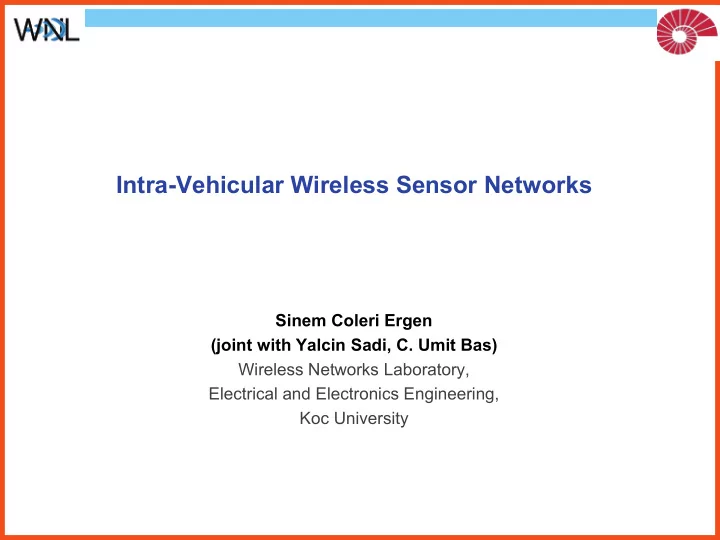

Intra-Vehicular Wireless Sensor Networks Sinem Coleri Ergen (joint with Yalcin Sadi, C. Umit Bas) Wireless Networks Laboratory, Electrical and Electronics Engineering, Koc University
Outline Motivation for Intra-Vehicular Wireless Sensor Networks Medium Access Control Layer Inter-vehicular networks
Outline Motivation for Intra-Vehicular Wireless Sensor Networks Medium Access Control Layer Inter-vehicular networks
History of In-Vehicle Networking Early days of automotive electronics Each new function implemented as a stand-alone ECU, subsystem containing a microcontroller and a set of sensors and actuators Data exchanged between point-to-point links Body Control Module ECU ECU sensor sensor
History of In-Vehicle Networking In the 1990s Increase in the number of wires and connectors caused weight, cost, complexity and reliability problems Developments in the wired communication networks Body Control Module ECU ECU ECU sensor sensor actuator sensor
History of In-Vehicle Networking In the 1990s Increase in the number of wires and connectors caused weight, cost, complexity and reliability problems Developments in the wired communication networks Multiplexing communication of ECUs over a shared link called bus Body Control Module ECU ECU ECU sensor sensor actuator sensor
History of In-Vehicle Networking Today Increases in number of sensors as electronic systems in vehicles are replacing purely mechanical and hydraulic systems causes weight, cost, complexity and reliability problems due to wiring Advances in low power wireless networks and local computing Body Control Module sensor sensor sensor ECU ECU ECU ECU sensor sensor sensor sensor sensor actuator sensor sensor
History of In-Vehicle Networking Today Increases in number of sensors as electronic systems in vehicles are replacing purely mechanical and hydraulic systems causes weight, cost, complexity and reliability problems due to wiring Advances in low power wireless networks and local computing Intra-Vehicular Wireless Sensor Networks (IVWSN) Body Control Module sensor sensor sensor ECU ECU ECU sensor sensor sensor sensor sensor actuator sensor sensor
First IVWSN Example: Intelligent Tire Active Safety Systems • Change the behavior of vehicle in pre-crash time or during the crash event to avoid the crash altogether • Examples: Anti-lock Braking System (ABS), Traction Control System (TCS), Electronic Stability Program (ESP), Active Suspension System Requires accurate and fast estimation of Enable a wide range of new applications vehicle dynamics variables • Forces, load transfer, actual tire-road friction, Intelligent Tire maximum tire-road friction available • More accurate estimation • Even identify road surface condition in real-time On-board sensors + indirect estimation S. C. Ergen, A. Sangiovanni-Vincentelli, X. Sun, R. Tebano, S. Alalusi, G. Audisio and M. Sabatini, “The Tire as an Intelligent Sensor”, IEEE Transactions on Computer-Aided Design of Integrated Circuits and Systems, vol.28, no.7, pp.941- 955, July 2009..
IVWSN: Distinguishing Characteristics Tight interaction with control systems Sensor data used in the real-time control of mechanical parts in different domains of the vehicles Very high reliability Same level of reliability as the wired equivalent Energy efficiency Remove wiring harnesses for both power and data Heterogeneity Wide spectrum for data generation rate of sensors in different domains Harsh environment Large number of metal reflectors, a lot of vibrations, extreme temperatures Short distance Maximum distance in the range 5m-25m
Outline Motivation for Intra-Vehicular Wireless Sensor Networks Medium Access Control Layer Inter-vehicular networks
Medium Access Control Layer: System Requirements Most of the packets generated periodically Network Control Systems (NCS): sensor data -> real-time control of mechanical parts Packet generation period, transmission delay and reliability ( T l , d l , r l ) requirements determined by NCS analysis Aperiodic packets generated rarely
Medium Access Control Layer: System Requirements Adaptivity and robustness requirement Nodes should be scheduled as uniformly as possible Allocate aperiodic packets Reschedule lost packets EDF Uniform
Medium Access Control Layer: System Model ( T l , d l , r l ) given for each link l 1 ≤ T 2 ≤ ... ≤ T L T Choose subframe length as for uniform allocation T 1 1 = s i T i / T s i Assume is an integer: Allocate every subframes ≡ Uniform distribution minimize max subframe active time max active time=0.9ms EDF max active time=0.6ms ✓ Uniform
Medium Access Control Layer: One ECU Maximum active time of subframes Periodic packet generation Delay requirement Energy requirement Maximum allowed power by UWB regulations Transmission time Transmission rate of UWB for no concurrent transmission case
Outline Motivation for Intra-Vehicular Wireless Sensor Networks Medium Access Control Layer Inter-vehicular networks
Inter-Vehicular Communication (IVC) Networks Safety applications Emergency situations such as accidents, icy road Require guaranteed delivery of data Up to now, satisfying these guarantees with random access protocols such as IEEE 802.11p protocol Investigate heterogeneous usage of LTE and IEEE 802.11p in providing more robust communication
Outline Motivation for Intra-Vehicular Wireless Sensor Networks Medium Access Control Layer Inter-vehicular networks
Thank You! Sinem Coleri Ergen: sergen@ku.edu.tr Personal webpage: http://home.ku.edu.tr/~sergen Wireless Networks Laboratory: http://wnl.ku.edu.tr
Recommend
More recommend